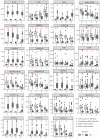Neutral Human Milk Oligosaccharides Are Associated with Multiple Fixed and Modifiable Maternal and Infant Characteristics
- PMID: 32244912
- PMCID: PMC7146356
- DOI: 10.3390/nu12030826
Neutral Human Milk Oligosaccharides Are Associated with Multiple Fixed and Modifiable Maternal and Infant Characteristics
Abstract
We aimed to identify if maternal and infant factors were associated with neutral human milk oligosaccharides (HMOs) variability and examined the associations between HMOs concentration and infant growth and disease status in healthy Chinese mothers over a 6-month lactation period. We recruited mothers and their full-term infants as our subjects. At 1-5 days, 8-14 days, 4 weeks, and 6 months postpartum, all participants were interviewed to collect breast milk samples, obtain follow-up data and measure infant length and weight at their local hospital. A total of 23 neutral HMOs were analyzed by high performance liquid chromatography (HPLC)- mass spectrometer (MS). Secretor and Lewis phenotype were determined by the concentration of 2'-fucosyllactose (2'-FL) and Lacto-N-fucopentaose (LNFP)-II. The associations between maternal and infant factors with HMOs concentrations were investigated. A total of 464 human breast milk samples were collected from 116 mothers at four different time points. In total, 76.7% mothers were found to be Secretor and Lewis positive phenotype (Se+Le+), 17.2% were Se-Le+, 4.3% were Se+Le-, and 1.7% were Se-Le-. Several individual HMOs, including 2'-FL, Lactodifucotetraose (LDFT), LNFP-I were determined by Secretor phenotype. Most individual HMOs decreased at the later stage of lactation, except 3'-FL. We suggest that Secretor phenotype and lactation stage could influence most of the neutral HMOs. Concentrations of specific HMOs may be associated with maternal age, allergic history, pre-pregnancy body mass index (BMI), parity, delivery mode, infant gestational age and gender.
Keywords: human milk oligosaccharides; influenced factors; lactation stage; secretor.
Conflict of interest statement
We declare that we have no financial and personal relationships with other people or organizations that can inappropriately influence our work.
Figures
Similar articles
-
The Mean of Milk: A Review of Human Milk Oligosaccharide Concentrations throughout Lactation.Nutrients. 2021 Aug 9;13(8):2737. doi: 10.3390/nu13082737. Nutrients. 2021. PMID: 34444897 Free PMC article. Review.
-
Human Milk Oligosaccharides Are Associated with Lactation Stage and Lewis Phenotype in a Chinese Population.Nutrients. 2023 Mar 15;15(6):1408. doi: 10.3390/nu15061408. Nutrients. 2023. PMID: 36986137 Free PMC article.
-
[Levels of human milk oligosaccharides in breast milk of mothers delivering preterm infants of different gestational ages and their effects on early growth and development].Zhonghua Yu Fang Yi Xue Za Zhi. 2021 Sep 6;55(9):1067-1076. doi: 10.3760/cma.j.cn112150-20210513-00468. Zhonghua Yu Fang Yi Xue Za Zhi. 2021. PMID: 34619923 Chinese.
-
1H NMR Metabolomics of Chinese Human Milk at Different Stages of Lactation among Secretors and Non-Secretors.Molecules. 2022 Aug 27;27(17):5526. doi: 10.3390/molecules27175526. Molecules. 2022. PMID: 36080292 Free PMC article.
-
Changes in HMO Concentrations throughout Lactation: Influencing Factors, Health Effects and Opportunities.Nutrients. 2021 Jun 30;13(7):2272. doi: 10.3390/nu13072272. Nutrients. 2021. PMID: 34209241 Free PMC article. Review.
Cited by
-
Modifiable and Non-Modifiable Factors That Affect Human Milk Oligosaccharides Composition.Nutrients. 2024 Aug 28;16(17):2887. doi: 10.3390/nu16172887. Nutrients. 2024. PMID: 39275203 Free PMC article. Review.
-
The Mean of Milk: A Review of Human Milk Oligosaccharide Concentrations throughout Lactation.Nutrients. 2021 Aug 9;13(8):2737. doi: 10.3390/nu13082737. Nutrients. 2021. PMID: 34444897 Free PMC article. Review.
-
Human Milk Oligosaccharides: Decoding Their Structural Variability, Health Benefits, and the Evolution of Infant Nutrition.Nutrients. 2024 Dec 30;17(1):118. doi: 10.3390/nu17010118. Nutrients. 2024. PMID: 39796552 Free PMC article. Review.
-
Human milk oligosaccharides and the association with microbiota in colostrum: a pilot study.Arch Microbiol. 2024 Jan 8;206(2):58. doi: 10.1007/s00203-023-03787-3. Arch Microbiol. 2024. PMID: 38191870 Free PMC article.
-
Consistency and Variability of the Human Milk Oligosaccharide Profile in Repeat Pregnancies.Nutrients. 2024 Feb 25;16(5):643. doi: 10.3390/nu16050643. Nutrients. 2024. PMID: 38474771 Free PMC article.
References
MeSH terms
Substances
Grants and funding
LinkOut - more resources
Full Text Sources
Other Literature Sources
Medical



